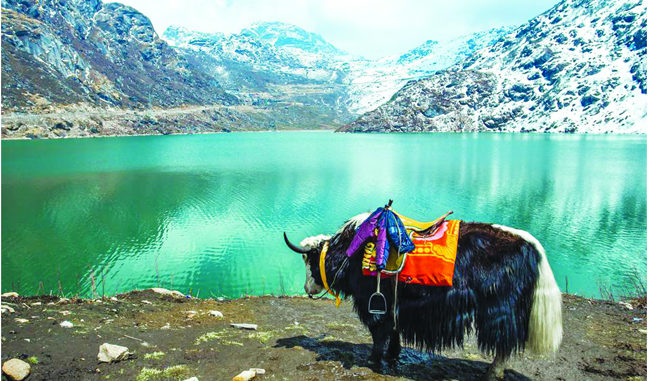
Sikkim situated in the Eastern Himalayan region with an area of 7,096 sq km and altitude ranging from 300m to 8,586m above sea level is a wonderland blessed with natural abundance from icy cold deserts, flowering alpine meadows, to lush green forests and emerald mountain lakes. The crowning glory of this wonderland is undoubtedly the magnificent Mt. Khangchendzonga (8,586m), the third highest mountain of the world. The mountain is not merely a physical entity but the abode of guardian deity whose benign watchfulness ensures peace and prosperity of the land.
It is possible to move from the sub-tropical heat of the lower valleys to the cold of the rugged mountain slopes that ascend up to the areas of perpetual snow in a matter of few hours. Such a steep rise in altitude over a very short distance, allows the land to host a robust natural heritage and wealth. The snow-capped mountain ranges, lush thick forests, plunging mountain valleys flush with rich flora and fauna, picture perfect villages, groves of rhododendrons, hot –springs, waterfalls, perennial streams and grand rivers Teesta and Rangit all contribute to shape Sikkim as a magical, mystical wonderland.
Keeping in tune with the natural diversity, Sikkim has an equally rich and diverse demographic structure with myriad of communities and religions and intricately knit colourful cultures, the basic connecting factor being the warm, welcoming nature of the people everywhere. The phrase “Atithi Devo Bhava” finds its true meaning in Sikkim. Diverse rituals, songs, dances, traditional dresses, folklores and legends fill up the cultural canvas of the State. The chimes of bells in the temples and the flutter of prayer flags in the monasteries create a feeling of righteousness and healing of spirit and soul. Feel rejuvenated, energised and spirituality enlightened in this holy land. Nature is revealed in its entire splendour in the serene lakes, cascading rivers and pristine waterfalls. Sacred lakes, waterfalls and hot water springs dot the mountainous landscape. Sikkim has a spectacular diversity of natural habitats and wildlife within a small geographic area of just 7,096 Sq. Km. From the river valleys and verdant forests to alpine meadows with rainbow of flowers blooming in monsoon; to the ice barren high glaciers and cold deserts – the vistas are endless and captivating for a visitor who is taken aback by such splendour.
DESTINATIONS GANGTOK
With magnificent views of the Kanchenjunga peak, uniqueness and vibrancy in colours of culture and tradition infused into the stunning sceneries and just the right dash of subtle city life is one of the most popular tourist destinations in the area. The name meaning hilltop, Gangtok can be safely said to be one of the most beautiful hill stations in the country.
YUMTHANG
Situated at a height of 11,800 feet, Yumthang is also known as the ‘Valley of Flowers’. It is considered a paradise for nature lovers due to its magnificent blend of rich flora and rare fauna coupled with its breathtaking scenic beauty. The best season to visit is spring, where the entire landscape is filled with colours of Primulas and Rhododendrons making Yumthang immensely popular among tourists. The Shingba Rhododendron Sanctuary cannot be missed especially with its 24 species of Rhododendron flowers.The hot spring located on the right side of Yumthang River is also a popular tourist attraction. Apart from the beautiful landscape, the valley is surrounded by Silver Fir and Pine trees, as well as cascading waterfalls and streams.
CHUNGTHANG
A small town on way to Yumthang in Sikkim, stands at the confluence of the rivers Lachen Chu and Lachung Chu. The North Sikkim highway bifurcates from here with one road leading to Lachen and the other to Lachung. Chungthang Valley is believed to be a holy place which has been blessed by Guru Padmasambhava, the patron saint of Sikkim. There is a rock here which to this day bears the hand and footprints of Saint Padmasambhava. From a small opening in the rock there is continuous flow of mineral water. There is a small patch of land here from which grows paddy every year. The nature defying miracle is believed to be the blessing of Guru Padmasambhava who sprinkled a handful of grain on the spot that has sprouted paddy ever since. Chungthang is a good place to halt before one takes off for the more alpine regions of Lachen, Lachung and the Yumthang Valley. Chungthang is mired in myths and legends, one such being that this is the place from where the word ‘Demazong’ [the hidden valley of rice, as Sikkim is known] first originated.
LACHUNG
Lachung, about 118kms from Gangtok in North Sikkim, is situated at an altitude of 8,858 ft. Also known as the ‘Small Pass’, Lachung is embraced by snow capped mountain peaks, breathtaking waterfalls, sparkling streams and apple orchards, also peaches and apricots. The market of this city is filled with handicrafts such as exquisitely woven rugs and blankets that make this town ideal for shopping sprees. The residents of Lachung who are mostly Bhutias call themselves Lachungpas.
PELLING
Pelling, a beautiful town in the West District of Sikkim, is becoming the second biggest tourist destination in Sikkim after Gangtok. The main attraction of the place is the breathtaking sight of the Khangchendzonga and the neighbouring peaks. The famous Pemayangtse monastery is less than a kilometre from here and is a major tourist spot. It also provides sites for mountain biking, rock climbing, village tours, meditation, educational studies and several other activities. The scenic town of Pelling is a perfect holiday destination for all nature lovers.





Be the first to comment